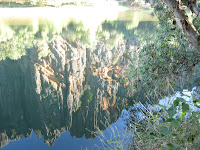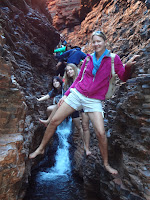 It's back to Adelaide sadly for work, just a 2 week stay but I'm not overly keen on going back to winter. Out onto the tarmac of the airport at 6am and it's certainly cold but not intensely. My Northern blood tends still only to be surprised by heat, not cold. One of the bosses picks me up and we drive out to Stirling. Back in the Adelaide hills and this time the pretty autumn colours have gone and it's damp and dismal. The wet, earthy smell as I get out of the car takes me back to England in an instant. As I mentioned before there is quite a population of English ex-Pats here- and I increasingly suspect it's because the winter reminds them of the English summer! I take an afternoon walk and get caught in a thunder storm.
It's back to Adelaide sadly for work, just a 2 week stay but I'm not overly keen on going back to winter. Out onto the tarmac of the airport at 6am and it's certainly cold but not intensely. My Northern blood tends still only to be surprised by heat, not cold. One of the bosses picks me up and we drive out to Stirling. Back in the Adelaide hills and this time the pretty autumn colours have gone and it's damp and dismal. The wet, earthy smell as I get out of the car takes me back to England in an instant. As I mentioned before there is quite a population of English ex-Pats here- and I increasingly suspect it's because the winter reminds them of the English summer! I take an afternoon walk and get caught in a thunder storm. Work is steady, pleasant. I finally see a possum... but euthanase it because it's very sick. Free time is spent catching up with people over the internet and updating blog whilst the internet's good- and trying to stay warm.
On my last day in Adelaide I visit one of the clients of the practice who rescues wildlife. She's currently hand-rearing 5 Kangaroos and 1 Euro (similar to a Kangaroo). Kangaroos are frequently hit by cars (actually, what they seem to do is hover at the side of the road waiting then make a dash at the very last second when there's no chance of avoidig them) but often the females have a youngster in the pouch which survives the crash and which is old enough to survive if given copious tlc.
These are essentially premature babies, a kangaroo enters the pouch as little more than a fetus and isn't really born as such until leaving the pouch at about 1 yr.
 In the house are 6 fabric pouch substitutes each with a small joey sleeping. I help feed and learn a bit more about kangaroos. It needs a whole lot more dedication than raising placentals (non-marsupial mammals) for instance a puppy opens its eyes at 2 weeks and is weaned by 5-6 weeks, these guys will need feeding for up to a year.
In the house are 6 fabric pouch substitutes each with a small joey sleeping. I help feed and learn a bit more about kangaroos. It needs a whole lot more dedication than raising placentals (non-marsupial mammals) for instance a puppy opens its eyes at 2 weeks and is weaned by 5-6 weeks, these guys will need feeding for up to a year.I go to a job interview in the afternoon as a last minute thing and have then the offer of work for October onwards, then it's back onto the plane for a late night flight to Darwin.




































